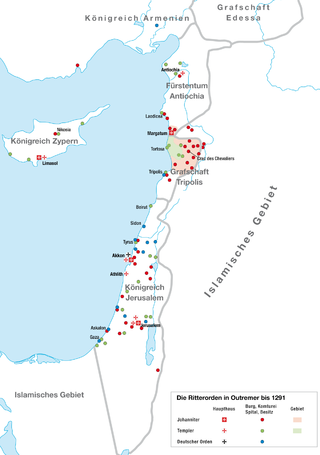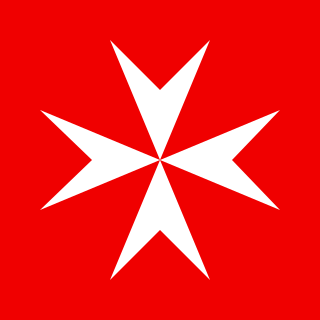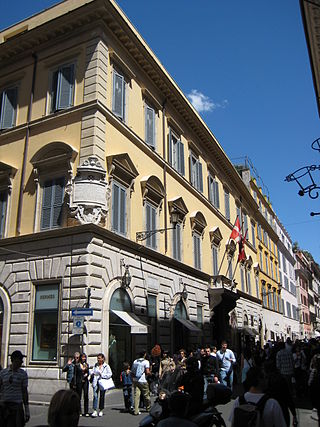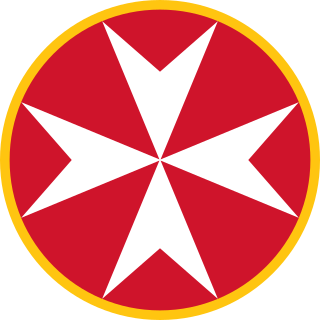
The Sovereign Military Order of Malta (SMOM), officially the Sovereign Military Hospitaller Order of Saint John of Jerusalem, of Rhodes and of Malta, commonly known as the Order of Malta or Knights of Malta, is a Catholic lay religious order, traditionally of a military, chivalric, and noble nature. Though it possesses no territory, the order is often considered a sovereign entity of international law.

A military order is a Christian religious society of knights. The original military orders were the Knights Templar, the Knights Hospitaller, the Order of Saint James, the Order of Calatrava, and the Teutonic Knights. They arose in the Middle Ages in association with the Crusades, both in the Holy Land, the Baltics, and the Iberian peninsula; their members being dedicated to the protection of pilgrims and Christians, as well as the defence of the Crusader states. They are the predecessors of chivalric orders.
The Russian tradition of the Knights Hospitaller is a collection of charitable organisations claiming continuity with the Russian Orthodox grand priory of the Order of Saint John. The order emerged when Malta was captured by Napoleon in 1798 during the expedition to Egypt. The Grand Master at the stronghold of Malta, Ferdinand von Hompesch, failed to anticipate or prepare for the threat. The Order continued to exist in a diminished form and negotiated with European governments for a return to power. The Emperor of Russia gave shelter to the largest number of Knights in St Petersburg and this gave rise to the Russian tradition of the Knights Hospitaller and recognition within the Russian Imperial Orders. In gratitude the Knights declared Ferdinand von Hompesch deposed and Emperor Paul I was elected as the new Grand Master. The continuous Order was also approved by the Papacy, but due to British fear of Russian taking presence in the Mediterranean and because many knights were Orthodox the Order became de facto the traditional Order but de jure not recognised similar or at par with the formation of the 19th-century Sovereign Military Order of Malta.

The Order of St John, short for Most Venerable Order of the Hospital of Saint John of Jerusalem and also known as St John International, is a British royal order of chivalry constituted in 1888 by royal charter from Queen Victoria and dedicated to St John the Baptist.

Andrew Willoughby Ninian Bertie was Prince and Grand Master of the Sovereign Military Order of Malta from 1988 until his death in 2008.

The Maltese cross is a cross symbol, consisting of four "V" or arrowhead shaped concave quadrilaterals converging at a central vertex at right angles, two tips pointing outward symmetrically.

The Equestrian Order of the Holy Sepulchre of Jerusalem, also called Order of the Holy Sepulchre or Knights of the Holy Sepulchre, is a Catholic order of knighthood under the protection of the Holy See. The pope is the sovereign of the order. The order creates "canons" as well as knights, with the primary mission to "support the Christian presence in the Holy Land". It is an internationally recognized order of chivalry.

The Bailiwick of Brandenburg of the Chivalric Order of Saint John of the Hospital at Jerusalem, commonly known as the Order of Saint John or the Johanniter Order, is the German Protestant branch of the Knights Hospitaller, the oldest surviving chivalric order, which generally is considered to have been founded at Jerusalem in 1099.
A dynastic order, monarchical order, or house order is an order under royal patronage. Such an order is bestowed by, as a legitimate fons honorum, a sovereign or the head of a once-sovereign ruling family. These are often considered part of the cultural patrimony of the ruling family. Dynastic orders were often founded or maintained to reward service to a monarch or their subsequent dynasty.

An order of chivalry, order of knighthood, chivalric order, or equestrian order is an order of knights, typically founded during or inspired by the original Catholic military orders of the Crusades and paired with medieval concepts of ideals of chivalry.

Grand Master a title of the supreme head of various orders, including chivalric orders such as military orders and dynastic orders of knighthood.

The Order of Knights of the Hospital of Saint John of Jerusalem, commonly known as the Knights Hospitaller, was a medieval and early modern Catholic military order. It was founded in the Kingdom of Jerusalem in the 12th century and had headquarters there until 1291, thereafter being based in Kolossi Castle in Cyprus (1302–1310), the island of Rhodes (1310–1522), Malta (1530–1798), and Saint Petersburg (1799–1801).

Palazzo Malta, officially named as the Magistral Palace, and also known as Palazzo di Malta or Palazzo dell'Ordine di Malta, is the more important of the two headquarters of the Sovereign Military Order of Malta, a Roman Catholic lay religious order and a sovereign subject of international law. It is located in Via dei Condotti, 68 in Rome, Italy, a few minutes' walk from the Spanish Steps, and has been granted extraterritoriality by the Italian Government. The Palace has been a property of the Order of Malta since 1630.

The Alliance of the Orders of Saint John of Jerusalem is a federation of European chivalric orders that share inheritance of the tradition of the medieval military Knights Hospitaller.
The Sovereign Military and Hospitaller Order of St. John of Jerusalem, Oecumenical Knights of Malta is one of the 26 unrecognised (self-styled) orders of St. John active in 2010. The order is not affiliated with the genuine Sovereign Military Hospitaller Order of Saint John of Jerusalem of Rhodes and of Malta, Venerable Order of St John and Order of Saint John, which are, respectively, a Roman Catholic, Anglican and Reformed-Lutheran order of Knights-Hospitallers; neither of the genuine Orders of Saint John is fully oecumenical. Their conjoint Committee on Orders of Saint John considers the so-called "Sovereign Military and Hospitaller Order of Saint John of Jerusalem, Oecumenical Knights of Malta" to be a "false" order.
The orders, decorations, and medals of the Holy See include titles, chivalric orders, distinctions and medals honoured by the Holy See, with the Pope as the fount of honour, for deeds and merits of their recipients to the benefit of the Holy See, the Catholic Church, or their respective communities, societies, nations and the world at large.

The Military and Hospitaller Order of Saint Lazarus of Jerusalem is a Christian self-styled order that was statuted in 1910 by a council of Catholics in Paris, France, initially under the protection of Patriarch Cyril VIII Geha of the Melkite Greek Catholic Church. During the 1920s, it expanded its jurisdiction and enrolled members from other countries in Europe and in the Americas. It re-established the office of grand master in 1935, linking the office to members of the Spanish branch of the House of Bourbon. It assumed an ecumenical dimension during the 1950s to expand its membership to individuals of other Trinitarian Christian denominations in British Commonwealth countries.

The flag and coat of arms of the Sovereign Military Order of Malta, or the Jerusalem flag, display a white cross on a red field, ultimately derived from the design worn by the Knights Hospitaller during the Crusades.

The Order of Saint John was organised in a system of commanderies during the high medieval to early modern periods, to some extent surviving as the organisational structure of the several descended orders that formed after the Reformation.











